Contemporary Lynx: Apparently, you like making references to Jan Matejko, saying that the reason you paint is to cheer people’s hearts. A Polish weekly newsmagazine “Przekrój” published an article entitled “Maciejowski: The New Matejko” (“Maciejowski: Nowy Matejko”). What is your opinion about such juxtaposition?
Marcin Maciejowski: The thing with cheering people’s hearts was actually a joke I made in one of my interviews. There may be a grain of truth in it, though. What “cheering people’s hearts” actually meant to me was positive energy, joy, something optimistic experienced by the people who saw my paintings. The “New Matejko” title on “Przekrój” cover was displayed along with “The Nude” picture and I’m not sure this combination worked properly. Most probably, it was associated with different kind of delights.

Marcin Maciejowski, I am happy thanks to my wife (Ingres), 50 x 70 cm, 2013, photo courtesy the artist
Of course, I admire Matejko for his attitude, diligence, his enormous scale of activity. The thing I really like in his painting are poses, gestures and facial expressions of depicted individuals. My latest exhibition (in Galerie Thaddaeus Ropac) was entitled “Fine gesture” (“Piękny gest”) which is a clear reference to my fondness for poses and gestures of painted figures, as well as to the importance I place on the act of painting itself – the way I use paints and a paintbrush. I have always been interested in what each canvas looks like from close up. Matejko’s paintings have no appeal when we watch them from close up. There are no tracks of his paintbrush. The paint looks like it was applied with a stick without any order. Only from a distance these large historical paintings look attractive, impressive. Furthermore they glisten unevenly because of varnish. I don’t like varnish. My paintings are matt.
CL: In the past, you used to claim that you were ashamed of being a painter. You didn’t like calling yourself a painter. Did your opinion on being an artist painter change and, if so, why?
MM: At that time I preferred to say that I took up painting or that I used painting as an instrument. The statement “I am a painter” sounded pompous to me. It was also false probably, because I did not study painting, but graphic arts (as well as architecture for three years beforehand). I didn’t study painting because I didn’t want to carry the “label” of a painter. I couldn’t stand impressionism, which was exactly what I used to associate with the Krakow school. I actually tend to be as stubborn as a mule, so when someone tries to pull me forward, I step back. Therefore, it was only after I started studying at the faculty of graphic arts and I had to make drawings that I went in the opposite direction and felt an interest in and a preference for painting, which was taught as an optional course that nobody really paid attention to. I used to paint a great deal at that time but I did it at home, as if secretly. Some time went by and a prominent gallery offered to organize an exhibition of my paintings, which evoked a common confusion at the university. I was about to have my paintings exhibited although I did not even study painting. Because of that, I did not refer to myself as a painter, which could have annoyed others. This kind of attitude suited me later on.
Apart from that, I come from a little village, where people used to associate the word “painter” with a wall painter. Once the locals asked me what I did for a living. When I told them that I painted they only nodded their heads in disbelief that I had studied for such a long time and took up such an unskilled job.
I don’t really care about such situations anymore. I kind of like this bit of gushiness, “artistic identity”. I can be a painter. I even like impressionists now.
CL: Who is a real artist, a painter in your opinion?
MM: I wouldn’t like to sound provincial, but generally speaking, for me a painter is a person who produces “painting” as a result of his or her work. Obviously, the painting I mentioned doesn’t have to be “a painting”, which you can hang on your wall. It can be some artistic activity in a given space, the painting phenomenon. It is actually hard to define.
It is the person looking at those results that determines who really is a painter and what painting is. It depends on what they feel and what emotions artistic forms evoke in them.
Some people get strongly emotional about garden arrangements, others about vividly coloured T-shirts of football players flickering against the green football pitch, whereas I am bothered by painted rectangles.
I expect a painter to make me feel extraordinary energy, to deliver a message and to share his observations with me. There is a saying: “we need to experience emotions” and have a feast (for the spirit). Everything needs to be served aesthetically, however. If that is the case, I will come back to this painter (and his works), like to a restaurant which serves tasty and nutritious meals.

Marcin Maciejowski, The artist indicates a crucial problem 150x100cm 2013, photo courtesy the artist
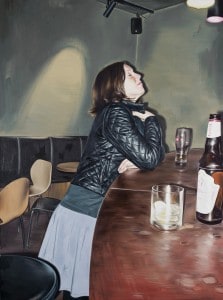
Marcin Maciejowski, Nina, 160 x 120 cm, 2013, photo courtesy the artist
CL: Are you emotionally attached to your own paintings? Is it difficult for you to part with them or are you glad to “send them away”?
MM: I obviously grow attached to my paintings, but the affection is not strong enough to prevent me from parting with them. For a painter, it is a great pleasure and satisfaction when his painting is bought. I paint for myself, but I also want other people to be able to look at my paintings. I literally live through each painting before and while painting it. These emotions persist. Apart from that, I keep records of my paintings, I photograph them, so that I always have the opportunity to look at them on my computer screen, to remind myself of them.
CL: You stated a few times that you didn’t like exhibitions and that it was wrong to exhibit too much. Why?
MM: What I meant was probably that when we exhibit too much, our audience can get tired. But honestly, I’ve already started enjoying my own exhibitions. The time I enjoy most are three months prior to a given exhibition, when I can already feel the tension of the opening day getting closer. This is when it’s easiest to paint. I also have the impression that were there no exhibitions, my willingness to paint would disappear.
CL: This year, you had your first individual exhibition in a public culture institution in the United Kingdom. How was your cooperation with BALTIC Centre for Contemporary Art Gateshead initiated? Were any of your works presented at this exhibition created specifically for this event?
MM: Not really. All of the paintings presented were created before and they belonged to various collectors from the UK. The exhibition’s curator, Laurence Sillars, was the person who selected works to be presented and worked out their arrangement.
CL: In 2001 you participated in a scholarship programme in Leverkusen – a thriving centre, which recently organized several interesting events devoted to Polish artists. Could you share your impressions about your stay there? Did it affect your work anyhow?
MM: I started this scholarship programme right after finishing my studies. It was a good thing because it did not leave me time to “celebrate” nor to think what to do next. I was thrown into the hustle of painting straightaway.
I remember having painted 36 paintings in just two months. It was in Cologne where I saw an arts fair for the first time. I had a headache because I felt overwhelmed with the amount of art works I saw there. Luckily, my scholarship was sponsored by Bayer, aspirin manufacturer, so I survived.
The most pleasant memory from my stay in Leverkusen is the visit of the famous painter Edward Dwurnik along with his daughter Pola, who is a painter as well. That was when I got to know him. He watched me working and asked why I didn’t clean the canvas with sandpaper after priming it, before I started painting. I used to prime canvases myself at that time and I have to admit that I did it quite unprofessionally. There were numerous lumps on my canvases – the surface was not smooth at all. Dwurnik’s remark influenced my work in a good way. I started to pay a great attention to the quality and smoothness of the canvas, the quality of a stretcher bar, paints, all general technical issues. It can be concluded that after my stay in Leverkusen I started to apply German quality standards while working on a painting.
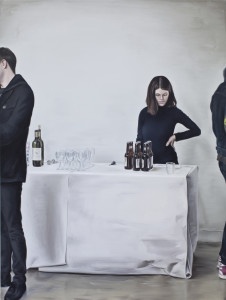
Marcin Maciejowski, Bar at Wilkinson Gallery, 2013, 200 x 150, photo courtesy the artist
CL: You cooperate with several prominent galleries abroad – Galerie Meyer Kainer in Vienna, Wilkinson Gallery in London and Galerie Thaddeus Ropac in Paris. How was your cooperation with these institutions initiated? Did it influence your perception of the Polish art market and artistic circles?
MM: My cooperation with Galerie Meyer Kainer started in 2002. My paintings were then presented during a small group exhibition in Vienna and this gallery noticed them and offered me the opportunity to cooperate. When I started to display my works in Meyer Kainer Galerie I was spotted and invited by other galleries.
I also need to mention the curator Goschka Gawlik, who was the first person presenting the works of Grupa Ładnie abroad (it was in 1999, as far as I remember). Not only my works were promoted this way. My colleagues from Ładnie first tried working with her. I joined this initiative later and stayed for a long time. But she showed a lot of initiative herself, for example she presented works of other young artists, who are now really successful abroad.
How did these experiences influence my perception of the Polish art market and artistic circles? Western galleries, at least the ones I work with, care about their artists a great deal. This is not the case in Poland.
CL: What are your impressions about the interest in Polish art in the West?
MM: In the West, there is a significant interest in art in general, regardless of where it comes from. If a piece of art is really good, it attracts everybody’s attention in any country. It’s the piece of art you see first, the artist’s name comes later. It can be the other way round, however. I don’t know how the western interest in Eastern European art exactly started and what it looks like now. I guess, Polish art as a whole attracts interest. Within that, there are particular names which are present in western galleries.
CL: Looking at your paintings, a change of interests can be easily spotted. In the past, you concentrated on presenting Polish mentality, which is full of contrasts, often seemingly irreconcilable. Nowadays, you hold a kind of dialogue with the art world. Picasso, Kantor, Klimt, Schiele… as well as “genre scenes” from galleries or pubs. For me personally, describing and presenting the art world with a pinch of bitter irony has the narrative and moralizing characteristics which are very similar to what was inherent in your previous series of paintings. So, what is your attitude to the art world?
MM: I realised that apart from being engrossed in everyday life, my wife, some politics and social conflicts, although to a much lesser extent, my genuine interest lies in ART in general – in its history, specific notions, the problems of artists. And since I always genuinely (adding a bit of irony) depict what matters most to me in my life, my observations about art started to emerge in my works.
I created paintings about significant events in the art history (for example “Zakopane used to attract artists, who found peace and inspiration there”), about specific artists, as well as paintings connected with my own artistic activity (“Why do you devote so little time to important themes?” or “Can’t you be more radical?”), about watching pictures (for example “-His second wife. 37 years younger than him” [about the portrait of Helena Fourment by Rubens]), the language used by critics.
You probably recollect the term “art world” from the picture “Are you really from the art world?”. In fact, it may be associated with my problematic artistic and social identity.
Actually, once I’ve heard a piece of conversation, an accusation against a person not engaged in fine arts that such person “does not belong to the art world” and there is no point starting any discussions with them. The person in question cited their connection with the “theatre environment”. Both sides tried to beat each other up with sophisticated terminology. Based on this conversation, I had some reflections, which led to creating this actual picture.

Marcin Maciejowski, Why do you devote…,150x100cm, photo courtesy the artist

Marcin Maciejowski, photo courtesy the artist
CL: In your previous opinions one can sense a bit of a disgust and reserve towards drive and willingness to be successful and famous. At the meeting in the National Museum in Krakow you said that “everybody deserves equal treatment” and that artists should not be classified based on the arbitrary notion of success. Could you please elaborate on that?
MM: I don’t remember what I had in mind at that particular moment, what made me say so. I associate fame with celebrity shows, light entertainment on television, some kind of unhealthy drive. Those are things I don’t like and try to remain detached from. The word “success” however, means a reward, something you achieve because you’ve done a good job. It may be about any profession, any sphere of life. Success is also associated with money, so everybody wishes to achieve it. Even artists, who are hypersensitive in spiritual matters, and completely do not care about material things.
I don’t remember what I meant by equal treatment neither. Now I think that anybody can classify artists according to their preferred criteria and choose which works enrich them personally and which don’t. For example, I am mostly fascinated and inspired by movies which are later described as dull in the reviews and which do not draw big audience. Sometimes a movie is nothing special in fact, but it contains one specific scene which is meaningful for me and which, of course, makes me paint it. Same thing with books I go through, one sentence is enough for me to state that the book is inspiring. I want to say that sometimes you can’t predict what will affect you emotionally: going to the exhibition in a prominent gallery or a trip to Castorama, where you can notice many inspiring shelves with screws, strips of wood or lavatories.

Marcin Maciejowski, Femina 31 x 31cm, 2010, photo courtesy the artist
CL: How did you become interested in the works of contemporary art classics? What was the impulse for creating this specific series of paintings?
MM: The point of departure for the paintings was my interest in art, not only from the perspective of an artist, but also a spectator. Cultured people discuss their artistic impressions with each other. I am alone in my studio, I have nobody to share my impressions with. Therefore, I started to “talk to the painting”, in other words to create paintings out of my own thoughts and impressions.
My first works on this theme were created after I saw beautiful photographs of the sculptures by Szapocznikow, Kobro and Karne in several catalogues. I liked them so much that I wanted to have them. Therefore, I painted them for myself based on the documentation I found, along with the captions.
Then, whenever I ran into the short notice in one women’s magazine about the record price for Picasso or Cezanne paintings, I didn’t announce this message on Facebook. I depicted it on my canvas instead.
Similarly, when I read in a book something about Modigliani’s elegance or Renoir’s nagging doubts I created paintings about it. Indeed, when I analyse my work I notice that the theme of art and artists is present in numerous paintings. Maybe I should change my interests now, start thinking about some trauma, gender, ecology.
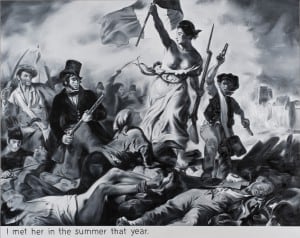
Marcin Maciejowski, In the summer 160×200 cm, photo courtesy the artist

Marcin Maciejowski, Veiled Woman (1879), 100x70cm, photo courtesy the artist
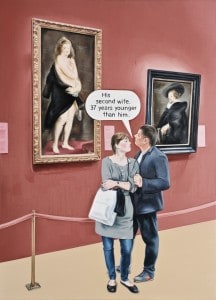
Marcin Maciejowski, His second Wife, 150×110 cm, photo courtesy the artist
CL: Are you inspired by any specific artists and their works? I’m asking you about it because just a few years ago you said that it was not any specific form of art, trend or the artistic activity of a specific person which attracted you, but rather this person’s life, the way they dealt with his or her artistic and life obstacles. On the other hand, you used to say that when you looked at Picasso works, they gave you a boost of energy and a strong motivation to work. So what is it like, exactly?
MM: It is exactly as you described in your question. As you mentioned, for me as an artist and for my paintings, the stories concerning artists’ life and their problems are more significant. The issues concerning art in general are vital as well. For example, I am fascinated by generic titles of the art works presenting traditional themes, like “Still life with…” or some activities, such as “A woman doing her hair”, “A girl reading”, “A girl dancing”, “Bar at…”. Such titles used to be given mainly to paintings created by the artists in the past. I used to pay no attention to such titles, but recently they became an impulse to create my own version of the themes, introduce some allusions, alternations. I really like the titles of pictures and I like inventing titles for my own paintings.
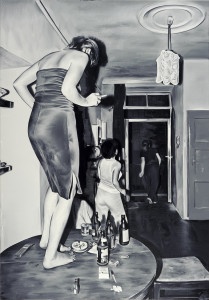
Marcin Maciejowski, Girl dancing, 140 x 200, 2011, photo courtesy the artist
As a spectator, I am obviously interested in all kinds of painting, but I place limitations on myself in order not to go mad with the excess of it. I don’t watch everything in one go. For example, when I am in Vienna, I only got to see: one Picasso painting, one Bacon painting and one Richter painting in MUMOK. This takes three hours. In Kunsthistorisches Museum I spend one hour looking at Caravaggio’s “Madonna of the Rosary” and another hour at “Het Pelsken” by Rubens. It is definitely enough emotions and sensations for one day.
When it comes to Picasso, while looking at his paintings I actually feel the energy, power and stimulation as if I drank a few cups of coffee. Simply speaking, to regain vigour and a will to live – try Picasso.
CL: Do you follow current exhibitions and what young artists are up to?
MM: I see more works by the artists who are either older than me or my age. Until last year, I used to think of myself as a young artist. It was only thanks to one of the critics, with whom I discussed art in Krakow, that I realised I am not a young artist anymore and that a lot of students left school since I graduated. Just joking.
I have to admit that I don’t follow young artists’ work. But if I have the opportunity to see something, I carefully watch what challenges young artists try to face. I think that young artists are more into installations, creating objects, projects, video clips. They rarely paint on canvas (there are a few exceptions, of course).
CL: There are many artists who started painting but later switched to installations or video clips. Some say that painting is in a crisis recently. You, however, still remain faithful to this technique. Why did you choose painting and what does it mean to you?
MM: I took up painting an drawing because I understood this sort of language and decided to communicate in it. I believe in what I paint and I don’t feel the need to express myself using different means. I found everything in painting. I see every single situation of everyday life as a kind of picture, I envisage what it would look like on canvas. I constantly think about painting, at dinner, while having a conversation with somebody, before I fall asleep. I like oil paints so much that were I forced to stop painting I would start working in a shop with paints (materials) for artists.
CL: Newspaper cuttings, a frame from a movie or photographs constitute points of departure for your work. What value and meaning do they have for you? In your opinion, where is the border between these two worlds (art and mass culture)?
MM: For me personally, the reason I paint a picture or draw a graphic is always the same. I realise that one particular photo, sentence, situation is suitable for a painting and should be painted on canvas or drawn on paper. When there is a reflection, values are emphasised or given a specific meaning, the border you mentioned is crossed. In other words, it occurs when an artist “indicated a crucial problem” (this caption comes from the painting “The artist indicates a crucial problem” exhibited in Galerie Meyer Kainer in June 2013).
CL: You often said that artistic means are not sufficient. That abstract painting itself is not attractive for you. Why are you so deeply interested in realism and narration, to which you remained faithful since the beginning of your work?
MM: In abstract painting, there are too many solutions, too many choices and I wouldn’t be able to pick just one of them. I felt such inability to decide when I studied architecture and I was about to draw my first designs for houses. I drew windows in walls. There were just too many solutions to apply, which is why I did not feel interested in this work. In the case of realistic painting or narration, I have a better feeling of what is the single proper solution for a given theme, the best sentence.
On the other hand, for me realistic painting, creating a realistic scene involves abstract construction. For example, when I paint a face, I don’t paint every smallest detail, because imitation is not my goal. I use brushstrokes or drawings in such way, that this oval shape with the shapes of the eyes, nose and mouth constitutes a tense, expressive piece of art, which has its new, independent quality. Due to this approach, while creating some paintings I can spend four hours looking for a single eyelid line, a drop representing a pupil. It actually resembles an abstract geometric painter who arranges a circle and a line in his composition or an architect who places a window in the right place on the façade.

Marcin Maciejowski, Elly Jones 1928. I wish you liked me, 26 x 20 cm, photo courtesy the artist
CL: In the past, while preparing to create artistic works you used to collect tabloids, such as “Super Express”, women’s magazines, you kept a notebook, etc. You changed the subject of your works, however. What is your present working routine? How do you collect materials for your paintings? I’ve heard that you collect catalogues presenting works by different artists.
MM: I still have the habit of buying newspapers and books. I don’t buy fiction, but rather biographies, historical books, guidebooks, picture albums. I wouldn’t say it’s the way of collecting materials for future paintings. I gather these things because I like paper and everything that is on it. I don’t read everything, more often I look through these publications and focus on illustrations.
I usually stumble across the materials I use in my paintings by accident. I don’t specifically look for them. I simply notice something and immediately know that it will make a good painting.
I still keep my notebooks and sketchbooks, but I no longer stick any cuttings inside. There are more sentences, titles and quotations than drawings now. I stick cuttings, printouts and photos onto the wall, in order not to forget about them.
As you mentioned, I am passionate about buying art catalogues presenting painting, architecture, photography. Those are always beautiful publications and it’s good to have them at home on the bookshelf. (Oh! I also gather shelves, tables, chairs, I can even say I collect them. I use these pieces of furniture while working: reading and drawing.)
Sometimes I tend to spend more time in a museum or a gallery bookshop than watching the exhibition in this very museum. When it comes to the catalogues presenting works of particular artists, I generally collect only ones on Picasso. I’ve already mentioned where my fascination with this artist comes from.
CL: Are you always sure what you are going to paint next, or you have some periods when you lack inspiration?
MM: I find the themes for my paintings on a regular basis, I only have to select them and prioritise as to which one to deal with first. Some paintings just want to be created immediately. I always paint just one work at a given time – from the beginning to the end. I never work on several paintings simultaneously. I paint regularly, maybe not every day, but, I would say, every night. I always work at night, sometimes till morning.
I have some empty periods after exhibitions, when a time for reflections comes and I need to contemplate what I’ve painted so far and take a fresh perspective on things. This is the time I need to start missing painting.
CL: Have you got any artistic goals you strive to achieve? Maybe there is a place you would like to host your exhibition or an art collection you want your works to be included in?
MM: I don’t really have such big exhibition dreams. I would just like to see my magnolia tree, which I planted two years ago next to my house, reach 7 meters. Reportedly, it is supposed to reach that height in 30 years.
CL: Thank you for this conversation.
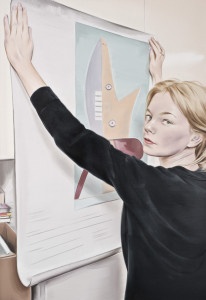
Marcin Maciejowski, Tete de jeune fille (1929), 100x70cm, photo courtesy the artist,










